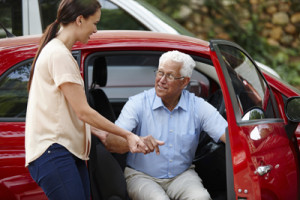 Being able to go wherever we want, whenever we want is a cherished freedom many of us have experienced since we first received our driver’s license. Driving is more than a routine part of adult life; it’s a powerful symbol of competence and independence. It’s also something we find hard to part with when the time comes.
Being able to go wherever we want, whenever we want is a cherished freedom many of us have experienced since we first received our driver’s license. Driving is more than a routine part of adult life; it’s a powerful symbol of competence and independence. It’s also something we find hard to part with when the time comes.
The focused concentration and quick reaction time needed for safe driving tend to decline as one ages, and for a person with Alzheimer’s disease, this process accelerates dramatically, which means it can be difficult for family members to know when it’s time for a loved one to hang up the keys.
The Warning Signs
Because Alzheimer’s disease reduces a person’s ability to reason and make good judgments, your loved one may balk at the request to stop driving, so it’s often up to family members to figure out when their loved ones’ driving abilities have become unsafe. Consider taking a drive with your loved one and watch for the following warning signs of unsafe driving:
- Forgetting how to locate familiar places
- Braking harder than normal for stoplights and stop signs
- Difficulty seeing things on the road
- Problems with changing lanes or making turns
- Running through stop signs
- Difficulty maintaining the car in the center of the lane
- Making slow or poor decisions
- Trouble turning his or her head before changing lanes
- Hitting the curb while driving
- Trouble adjusting to the oncoming glare of headlights
- Driving at an inappropriate speed (either too fast or too slow)
- Increased frustration, anger, or anxiety when driving
- Failure to use turn signals or mirrors
- Becoming angry and confused while driving
- Confusing the brake and gas pedal
- Increased confrontation with other drivers
- Failing to observe traffic signals or running through stop signs
- Becoming confused in simple driving situations or lost in familiar areas
- A series of close calls, collisions, or driving violations, even if they are minor
Most specialists feel it’s important to help the person with dementia stop driving as soon as possible. Think of it this way: do you feel safe riding in a car or having your family members, including children, riding in a car driven by the person with dementia? Consider also whether you would feel safe if your children were playing on the sidewalk on a street where the person with dementia was driving. If the answer is no, then you know it’s time for him or her to retire from driving.
If your loved one refuses to stop driving, a good suggestion is to check with the state Department of Motor Vehicles to learn the process for evaluating the person’s ability to continue driving safely. A number of MVA offices provide thorough driver safety evaluations to confirm whether the person can continue to drive safely. You can also request a note from your loved one’s physician that states that he or she should stop driving, or simply take control of the keys if needed.
Remember that the ability to drive gives your loved one a sense of independence, and losing that ability isn’t easy. Arranging for alternative transportation via the services of Visiting Angels can help ease the transition.
At Visiting Angels, we can help your loved one stay active and engaged with transportation to visit friends and family, to medical or hair appointments or outings to go shopping, to the park, to church, or wherever desired. Accompanied by a trusted Visiting Angels caregiver, private or public transportation can be used. If it’s time for your senior loved one to give up the keys, contact us at 408-735-0977 or 510-284-0000. We’re always available to plan and arrange for your loved one’s accompanied transportation needs, and to assist with any other California senior care services you need.

